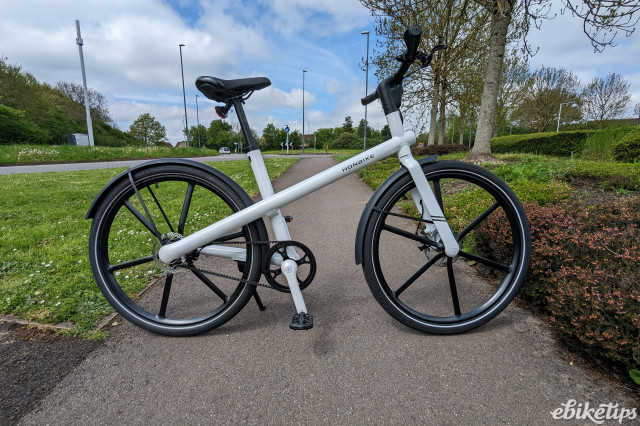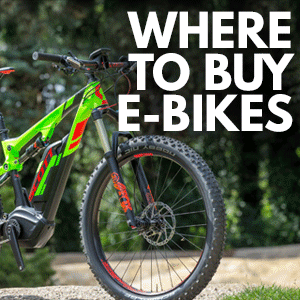Review: Himiway A7 Pro

Overview
- Great motor
- Very comfortable
- Surprisingly good off-road
- Very heavy
- Non-clutched derailleur
The recently released Himiway A7 Pro is a full-suspension step-through e-bike aimed at commuters and the more adventurous leisure riders. It boasts a mid-drive motor and an impressive 720Wh battery. I’ve been testing the Himiway on and off the road to see how it performs.
Himiway, known for its portly hub-powered fat-tyre e-bikes, has taken a new direction with the A7 Pro. This model combines a step-through frame with normal-sized tyres, air suspension, and advanced features, such as a torque-sensing mid-drive motor and integrated colour display.
A two-man team delivered the test sample and kindly brought the bike into my house. The packaging is impressive — the entire bike was encased in moulded foam. Due to the weight, you’ll struggle to lift the bike out. Cutting the front off the box is easier. The bike includes an accessory pack with tools, pedals, a charger and some reasonably good instructions.
You should allow an hour for the assembly process, which is fairly straightforward. However, it is a heavy bike, and having two people makes the job easier. The handlebars, front mudguard, light, front wheel, and seatpost need to be fitted. As with any bike assembly, it’s always worth getting the help of a professional, if you're unsure of anything.
The A7 Pro is available in five different colours. This one came in a deep gloss emerald green — one of the nicest colours I’ve seen on an e-bike. It has a purposeful look, with big 650b x 60mm Schwalbe tyres and Suntour X1 Boost air forks.
For a step-through, it’s a cool-looking bike. Unfortunately, all this comes with a substantial weight penalty, meaning the A7 Pro tips the scales at an eye-watering 35kg.
The ride
With a fully charged battery, I headed off for my first adventure. I decided on a 30-mile ride, with some off-roading around Dartmoor. The first thing that struck me was how quiet the mid-drive motor is. The Ananda M100 is designed for e-cargo bikes and produced a very useful boost from the off.
With five levels of assistance, you can fine-tune the power to suit your needs. I started off using level one and found it to be sufficient on the flat. However, levels two and three work better for moderate hills. Levels four and five are only necessary for the steepest of slopes.
The torque sensor is highly responsive, and as soon as you start pedalling hard, the motor rewards you with a smooth burst of power, quickly ushering you to the 15.5mph cut-off point. Walk assist is activated by holding down the minus key on the keypad.
Despite its weight, the Himiway rolls surprisingly well. On flat terrain, you can maintain a speed just above the assistance limit without exerting too much effort. The additional weight only becomes noticeable when you encounter an incline, at which point the motor kicks in again.
The A7 Pro has excellent handling and behaves impeccably on the road. It’s easy to manoeuvre at low speeds and feels firmly planted at higher speeds, which is probably due to the low-slung motor and battery. The suspension system does an excellent job of minimising road noise and vibrations, providing a "magic carpet ride".
For the hill test, I tried a one-mile climb with an average 7% gradient and a steep 15% section in the middle. I kept the assist in level three and was able to reach the top comfortably. In the past, I’ve tackled the same climb on various hub motor e-bikes and been out of breath by the top. I also tried it up my local 25% climb, and it got up there without a fuss.
For the off-road test, I decided to do a loop of Burrator reservoir. The route included steep climbs on loose gravel and fast, flowing single track. I had to contend with some muddy sections and deep puddles during the ride. The Schwalbe Super Moto-X tyres were pretty good but are definitely more suited to dry conditions. I rode with a friend who was on a more expensive Bosch CX-powered Trek Powerfly 5, and the Himiway held its own remarkably well against the more expensive bike.
Specification
The alloy frame appears to be well made, with smooth welds and a flawless paint finish. The frame's geometry clearly shows the bike's adventurous intentions with its slack head angle and long wheelbase. As for the suspension, the rear triangle is separate and pivots at four points.
The motor is an Ananda M100 mid-drive. It’s not a brand I’m familiar with, but the performance speaks for itself. (They have been producing e-bike motors for over 20 years.) It’s a gem that’s very smooth and at least as quiet as a Bosch motor. I rode this and my friends Bosch CX bike back-to-back up a steep gravel track, and the Himiway felt like it had more grunt in the highest assist setting.
High-torque mid-drive motors can cause premature wear to a bike’s drivetrain, so they've fitted, a gear shift sensor. The gear cable runs through the sensor (located on the chainstay), so every time you change gear, there’s a momentary drop in power. This helps reduce excess wear to the chain, derailleur and cassette.
The high resolution colour display is vivid and sharp. It shows battery level and real-time voltage. There’s also a motor power indicator. The speed can be switched between mph and km/h, and there’s the usual trip function. There’s no Bluetooth connectivity though - albeit that shouldn’t be a deal-breaker for most people. The functions are controlled via a keypad located next to the left-hand grip. A long press on the plus key activates the lighting.
The removable battery is a 48V 720Wh one with Samsung cells and fits neatly into the bike's downtube. Interestingly, Himiway’s claimed range of 50 miles is actually less than I managed on the first charge. After two rides up to Dartmoor, I had ridden 58 miles before the last bar started flashing.
That’s pretty good, considering the elevation gain for the two rides was 4,400ft combined. I used levels two and three throughout. If you tanked it everywhere in level five, I reckon you’d still manage 35 miles and if you used the lowest level on flatter terrain, 65-70 miles may well be possible.
It's uncommon to see a full suspension step-up on a step-through e-bike. The A7 Pro features an SR Suntour X1 boost fork with 120mm of travel at the front and a DNM AO-38RL air shock at the rear. The suspension performs well both on and off the road and is much better than typically found on a hybrid bike.
The gearing is Shimano’s Alivio mountain bike set-up with a 44t chainring and 11-34 9-speed cassette. This keeps the gearing high enough for road riding and low enough for moderate off-roading. The shifting is spot-on, and the motor produces enough power to negate the need for lower gearing. My only complaint is that the derailleur lacks a clutch and bounces around when riding off-road, which resulted in a dropped chain a couple of times.
Braking is provided by Shimano's entry-level MT200 hydraulic brakes with 180mm rotors. Despite riding through mud and standing water, I didn't face any issues with the brakes and they have performed well under normal riding conditions so far.
The 650b wheelset is shod in Schwalbe Super Moto-X tyres, which measure 2.4in wide. Despite the road-friendly tread pattern, they handled off-road riding surprisingly well. They’re good for gravel but will slide around on muddy sections. The wheels have eyelets on the rims, thick spokes and sealed bearings. As a bonus, the freehub makes a pleasing buzz when coasting, more like the sound you’d get on a high-end wheelset.
The finishing kit includes some neat touches, including a dropper seatpost (of sorts). It actually works very well, and means you can easily adjust the seat height and also lower the saddle quickly if you have trouble getting on and off the bike. It also functions off-road when you want to lower your centre of gravity on the descents. The handlebars are a good width at 680mm, and the stem can be adjusted.
The A7 Pro has just about everything regarding accessories. For starters, there are front and rear metal mudguards, a very nice MIK pannier rack (with bungee), and an Abus wheel lock. The kickstand is very sturdy, and the lighting system is excellent.
Comfort and sizing
Regarding comfort, the Himiway comes up trumps. In fact, it’s one of the most comfortable electric bikes I’ve ridden. The suspension smooths out rough roads, and the riding position (for me, at least) is just right. After riding nearly 60 miles over two days, I had no discomfort anywhere, and I would have no hesitation in riding that distance in one go.
For rider size, Himiway recommends 5ft 4in to 6ft 5in. Despite quite a lot of adjustment in both the stem and saddle, it’s still a big and heavy bike. It’s a little too big for my 5ft 4in daughter to ride comfortably, but my older daughter who is 5ft 9in had no problems. I’d say the optimal rider height would be somewhere between 5ft 7in and 6ft 3in.
As far as carrying capacity is concerned, Himiway recommends a maximum load of 136kg. This would give someone like me an additional 31kg of carrying capacity, which is pretty good
Alternatives
Priced at £2,399, the Himiway A7 Pro offers a lot in terms of specification and performance. It is difficult to find similarly priced step-through e-bikes with full suspension from other brands. The warranty is two years and covers all electric components and the frame.
At £2,999, the recently-reviewed Ecomove Bird M is the closest alternative I could find in terms of specification. It features dual suspension with fat tyres and uses a Bafang M510 mid-drive and 720Wh battery.
The Romet E-Modeco URB 3.0 is another sub-£3,000 mid-drive step-through with a great spec for the price. It uses the excellent Shimano EP8 motor with an impressive 840Wh battery. The price is also very reasonable at £2,999.
Beyond this, you’re into Cube Kathmandu territory, and these start at around three grand and go up to over £4k.
Conclusion
I have to say, I was thoroughly impressed with the Himiway A7 Pro. Compared to other models in their range, it’s a breath of fresh air. Apart from a few minor quirks, it’s hard to find fault.
The elephant in the room (pardon the pun) is the Himiway's 35kg weight. This may limit its appeal, especially if you need to put it on a bike rack or take it anywhere that requires lifting it. If the weight isn’t an issue, and you need a step-through e-bike with a punchy motor and all-road capabilities, you could certainly do a lot worse for your money.






















